Oregon is home to a diverse array of wildlife, and among its many inhabitants are several species of black spiders. These eight-legged arachnids are a common sight in many parts of the state, and their distinctive coloring and web-spinning abilities make them easy to identify. Although black spiders might make certain individuals uneasy, they play a crucial role in the ecosystem by regulating populations of other insects and serving as a food source for birds and other predators. So next time you spot a black spider, take a moment to appreciate the complexity and beauty of this remarkable creature. With that being said, let’s discover everything about six black spiders in Oregon!

1. Western Black Widow (Latrodectus hesperus)
The western black widow spider is infamous for its bite and it is one of the most dangerous black spiders in Oregon.
Its body size is approximately half an inch in length, and it is predominantly black in color. A distinguishing feature of the female spider is the presence of an hourglass-shaped red mark on the underside of the abdomen, although this mark can be yellow or white in rare instances. Males of the species are smaller, measuring around half the length of females, and have a tan coloration with lighter striping on the abdomen.
The webs created by western black widow spiders do not have a fixed shape or structure and can appear different depending on their location. These arachnids produce silk for their webs using a liquid derived from their large abdominal glands.
Like many other arachnids, the western black widow spider primarily feeds on insects. These spiders use the sticky silk in their webs to capture their prey. They tend to live in various locations, such as under ledges, plants, rocks, and other types of debris. They usually build their webs closer to the ground.
When a western black widow spider bites, the effects can range from mild irritation to severe autonomic imbalances. The venom of these spiders contains a combination of proteins, peptides, and proteases. When injected into the bloodstream, the venom triggers an over-release of neurotransmitters, leading to a variety of symptoms such as muscle stiffness, excessive sweating, and nausea.
Fun Facts
- These spiders face predators such as mice and birds.
- Western black widows are known to be opportunistic cannibals.
- These spiders are commonly found in areas close to the United States–Canada border.
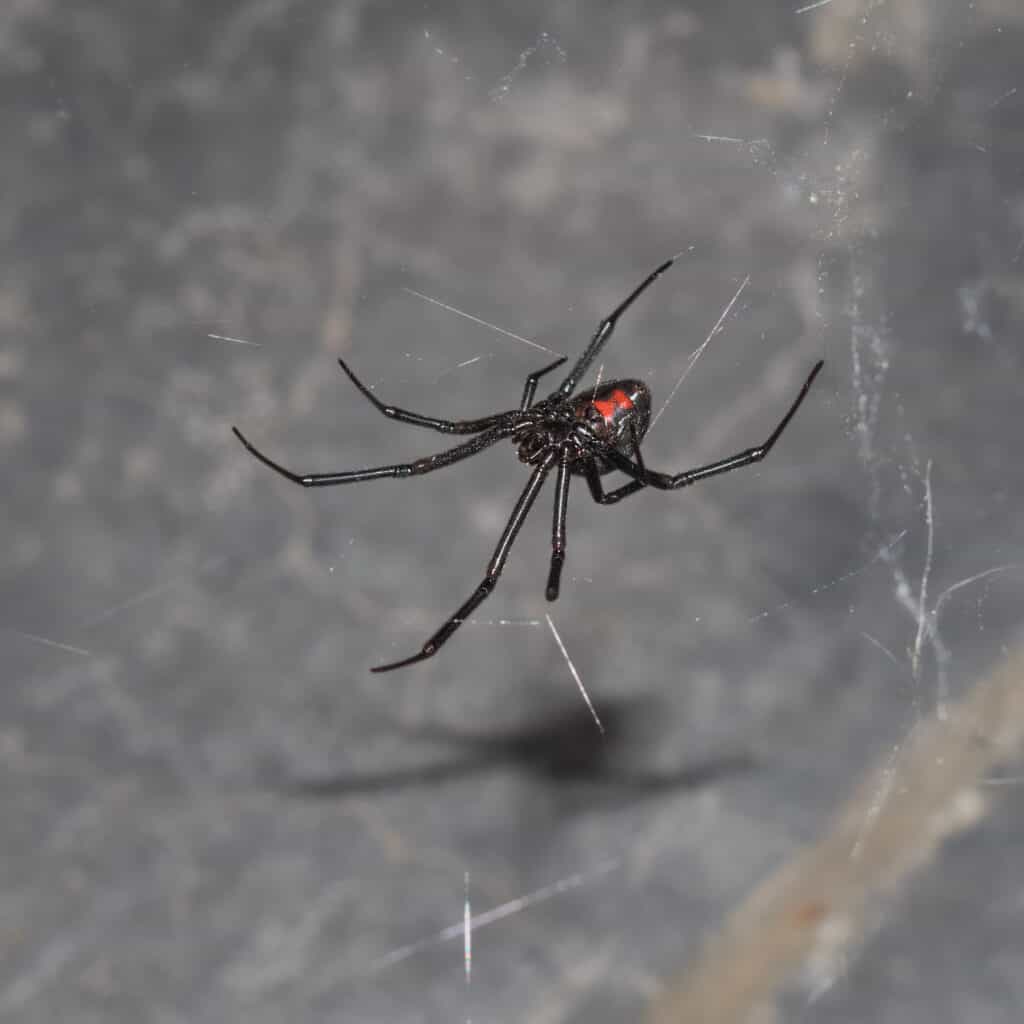
The western black widow spider is infamous for its bite and it is one of the most dangerous black spiders in Oregon.
©iStock.com/Shravan Sundaram Photography
2. Mouse Spider (Missulena)
Native to Australia, the mouse spider has somehow made its way to North America and can be found in Oregon. The size of mouse spiders ranges from 0.39 to 1.18 inches, so they are among the largest spiders in Oregon. They possess a shiny carapace and a broad head that is raised, with eyes evenly distributed across the front of the head. The abdomen has short spinnerets at the back.
These arachnids display sexual dimorphism, which is when the males and females look very different from each other. While females are completely black, males have distinct coloration that varies between species.
The mouse spider gets its common name from the belief that it can dig deep burrows similar to those of mice, but this assumption has recently been found to be incorrect. While these spiders are capable of burrowing, their burrows differ from those of mice. It is also important to note that mouse spiders are not related to mice in any way, and these creatures do not resemble each other.
Semi-arid forests or open shrublands are common places where people come across mouse spiders. Their habitat range may differ slightly depending on the species. These spiders mainly feed on insects, small creatures, and other spiders. Although there is speculation that western black widows may attack and feed on mice, there is currently no concrete evidence to substantiate this claim.
Although bites from mouse spiders are painful, they are not typically dangerous. Documented cases in the medical literature have shown that antivenom treatment is usually not necessary, and serious symptoms are rare.
Fun Facts
- The genus comprises approximately 11 species, with all except one being native to Australia.
- Missulena species create burrows that serve as both a breeding ground and protection against predators and extreme weather conditions.
- These spiders are known for their tendency to take an attacking stance when they feel threatened.
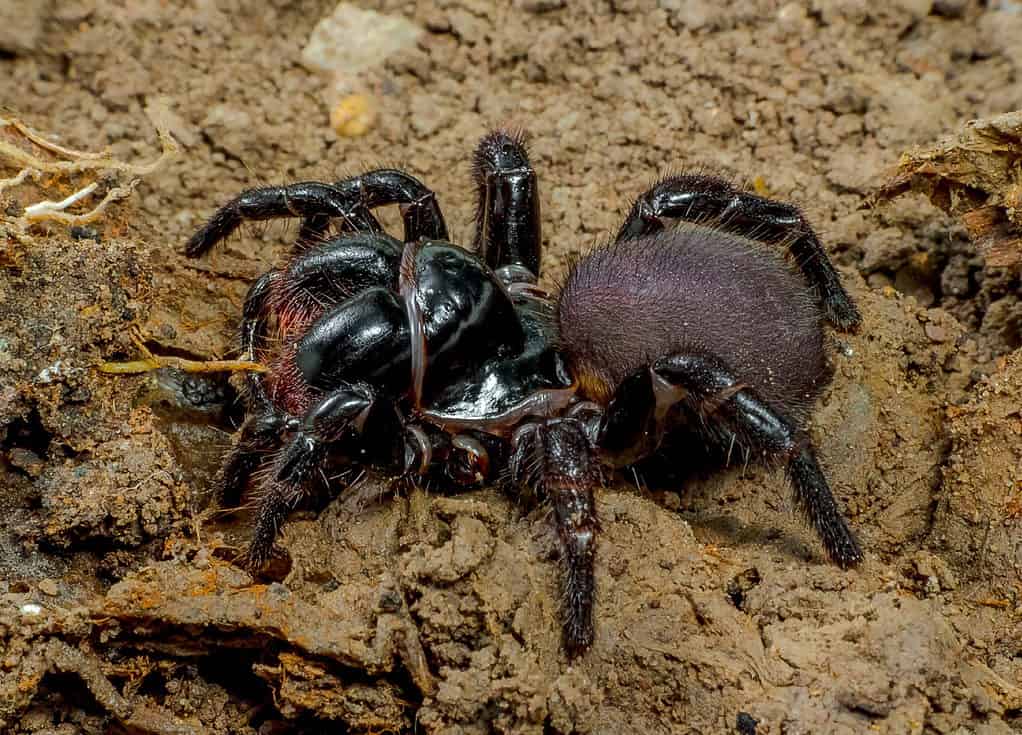
The size of mouse spiders ranges from 0.39 to 1.18 inches, so they are among the largest spiders in Oregon.
©Robertwhyteus, CC BY 4.0 <https://creativecommons.org/licenses/by/4.0>, via Wikimedia Commons – License
3. Western Parson Spider (Herpyllus propinquus)
A member of the Gnaphosidae family, the western parson spider is a ground-dwelling species found in the state of Oregon.
The western parson spider, scientifically named Herpyllus propinquus, gets its common name from the distinct scalloped median abdominal stripe that resembles the cravat worn by parsons or ministers in the past. This species of spider is typically half an inch long and can be found in colors ranging from brown to black. The entire body of the spider is covered with short hairs, and its legs often exhibit a reddish-brown hue.
This spider species is a cursorial hunter, and unlike many other spider species, it doesn’t use webs to catch prey. Instead, it has evolved for high-speed endurance running to capture its prey.
Typically, the western parson spider can be found outdoors, residing under rocks or in brush or firewood piles. When indoors, this spider is known to roam about at night and take refuge during the day under objects or in clothing. As for its diet, this spider feeds on other spiders and has a particular fondness for hunting and consuming wolf spiders. It also preys on various kinds of insects.
Although the western parson spider is not considered venomous, the symptoms of its bite can vary in severity. Some individuals may only experience initial pain and localized allergic swelling and itching, while others may experience more severe symptoms such as swelling, nausea, nervousness, elevated temperatures, and sweating.
Fun Facts
- Found all across the United States, the species is native to North America.
- As an ambush predator, the spider relies on fast movements to swiftly bite insects it comes into contact with.
- In the event of a bite, an open wound may develop.
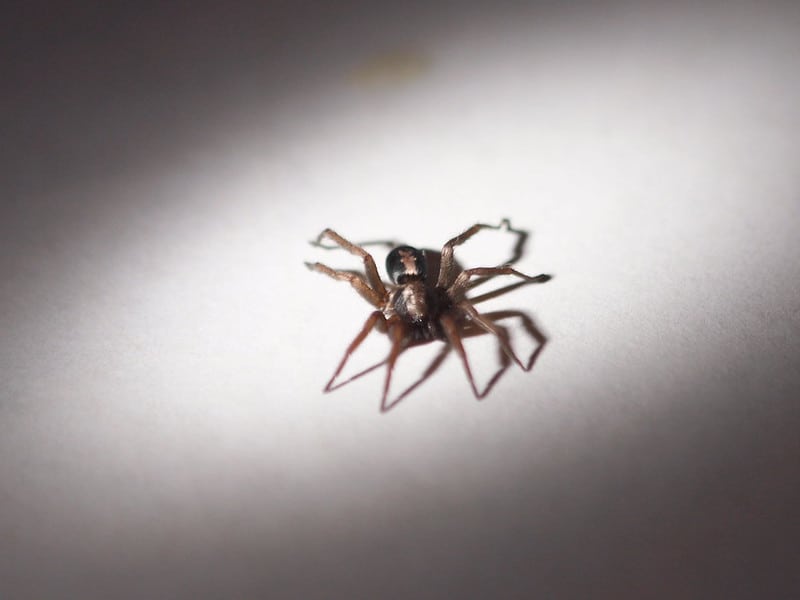
The western parson spider gets its common name from the distinct scalloped median abdominal stripe that resembles the cravat worn by parsons or ministers in the past.
©lostinfog, CC BY-SA 2.0 <https://creativecommons.org/licenses/by-sa/2.0>, via Wikimedia Commons – License
4. Red-Backed Jumping Spider (Phidippus johnsoni)
The red-backed jumping spider is one of the most common jumping spiders in Oregon.
Identifying the red-backed jumping spider is relatively easy due to its distinct appearance. The spider’s body is primarily black, while its abdomen is a bright shade of red. In male spiders, the abdomen is completely red, while in females, there is a black longitudinal stripe running along it. Occasionally, the abdomen may also have small white or yellow dots and a thin yellow or white line surrounding the red area.
While still small, this spider is larger than other jumping spiders. Female spiders typically measure between 0.35-0.55 inches in body length, while males are smaller and average around 0.25-0.45 inches in size.
The red-backed jumping spider is known to inhabit various environments, such as under rocks, in wooded areas, and on the ground. They have also been spotted on grape vines. As for their diet, the species has a broad range of food preferences, including bugs, flies, and moth caterpillars, both in their larval and adult stages. They are also known to consume other types of spiders.
During the mating process, male red-backed jumping spiders engage in unique courtship behavior, which involves performing a dancing ritual. Notably, some male red-backed jumping spiders are known to create a unique sound by twitching their abdomens.
The red-backed jumping spider is not considered dangerous to humans, and its venom is not toxic to people.
Fun Facts
- In 2012, a red-backed jumping spider was sent into space by NASA.
- They are not typically aggressive and prefer to flee from danger.
- The species is often preyed upon by birds, lizards, larger spiders, and other types of reptiles.
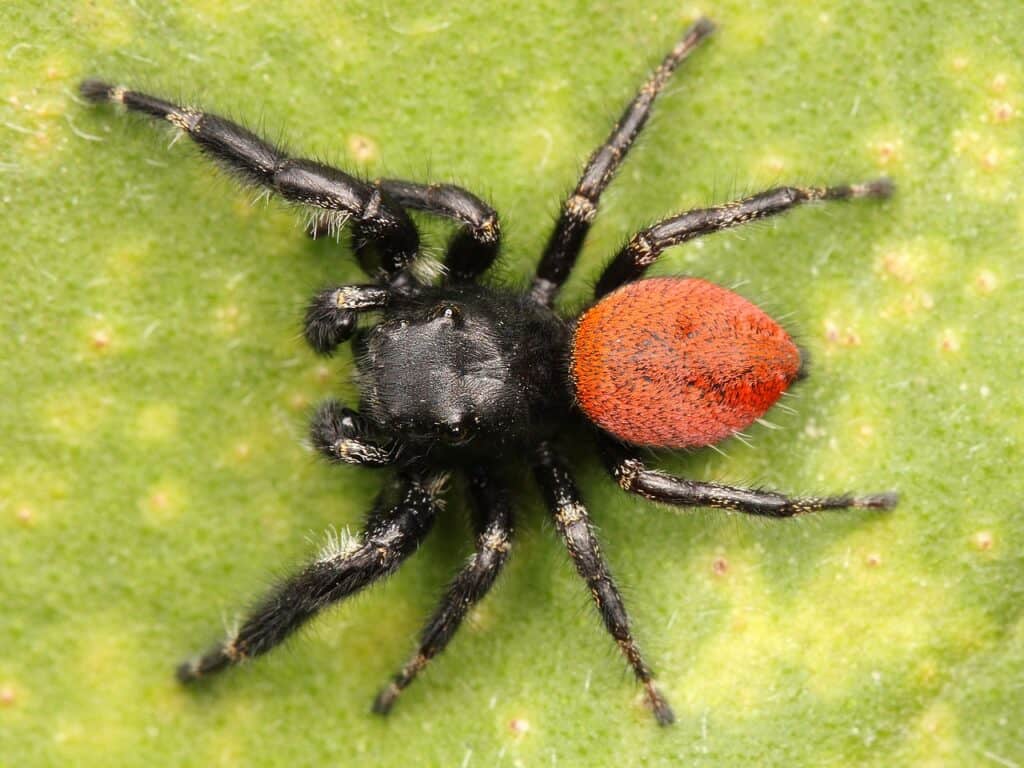
The red-backed jumping spider is identifiable thanks to its bright red abdomen.
©Kaldari / CC0 via Wikimedia Commons – License
5. Pacific Folding-Door Spider (Antrodiaetus pacificus)
Among the black spiders in Oregon, the Pacific folding-door spiders definitely have the most enormous fangs! This species is characterized by stocky bodies and thick legs. It gets its name from the way they shut the entrance to their silk-lined burrows by pulling in the rim.
This spider has eight eyes, with two eyes in the center and three eyes on each side of the pair in the middle. The color of the Pacific folding-door spider varies from light brown to black. The carapace of both males and females ranges in color from dark brown to black and is marked with two to three sclerotized patches on the abdomen. Females are typically around 0.51 inches long, while males are slightly smaller, averaging around 0.43 inches in length.
Pacific folding-door spiders thrive in cool and damp forest environments, where they construct burrows in soft substrates such as sand, moss, or decaying wood. They use these burrows to brood their eggs and hibernate during the winter months.
During the day, the entrance to their burrow is kept closed, but once the sun sets and it becomes dark enough, they open the burrow and wait at the entrance for potential prey to pass by. These spiders primarily prey on beetles.
Their venom glands are relatively small, and as a result, their bites are not typically considered dangerous to humans. However, a bite from this spider may still cause significant discomfort and pain.
Fun Facts
- The Pacific folding-door spider is active year-round, but the majority of its activity is observed between late July and early September.
- Unlike other spider species, the Pacific folding-door spider does not spin webs.
- There are around 27 known species of folding-door spiders.
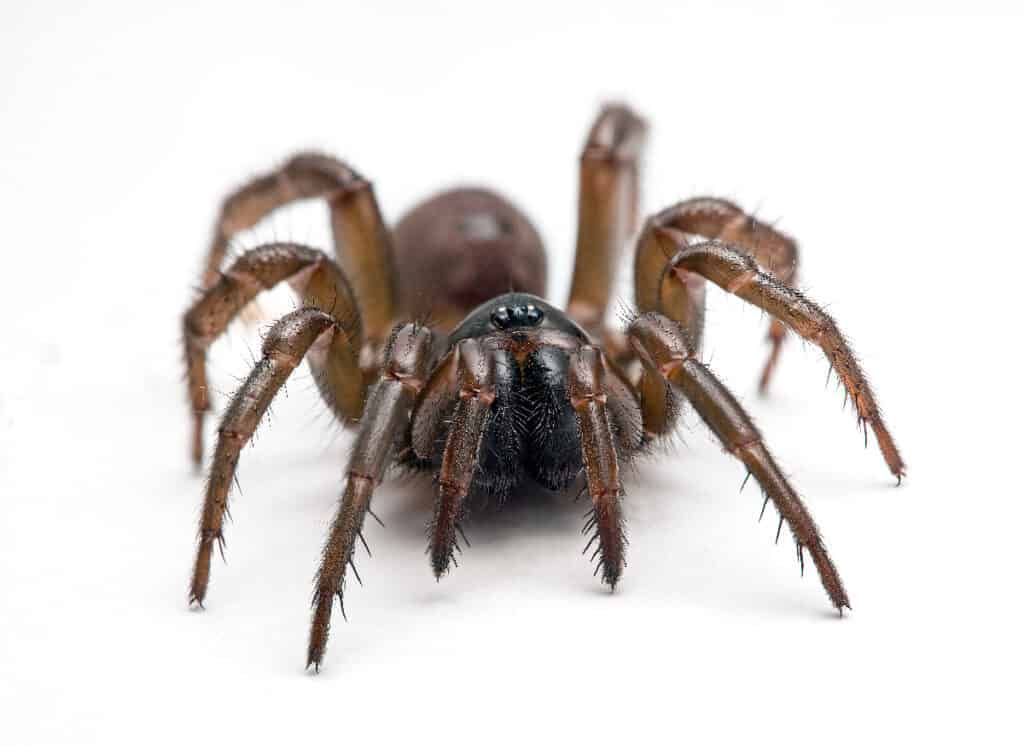
Pacific folding-door spiders are characterized by their stocky brown bodies, thick legs, and enormous fangs.
©Ernie Cooper/Shutterstock.com
6. Long-Palped Ant Mimic Sac Spider (Castianeira longipalpa)
Although it is called the long-palped ant mimic sac spider, its appearance does not closely resemble that of an ant. However, spiders belonging to the Castianeira genus, which also mimic ants, exhibit similar behaviors and movements.
The physical features of these spiders can vary depending on their sex and age. Predominantly black, the abdomen of the spider has at least four white or light gray stripes on the sides. The cephalothorax, or head area, may come in shades of black, brown, or grayish-white. The legs of juvenile spiders are entirely translucent brown, while the first two pairs of legs in adult spiders usually have a brown color towards the end and black near the body.
Female spiders can grow up to half an inch in size, while males are generally smaller.
This is a type of predatory spider that doesn’t rely on webs to capture prey. Instead, it actively hunts down small creatures like ants. This species of spider is known for its striking appearance and can be found in various habitats, often in close proximity to the ground, such as under logs, fallen leaves, or rocks.
This speedy spider may come across as somewhat aggressive due to its quick movements. However, when faced with much larger beings, such as humans or pets, their initial response is usually to flee. As a result, spider bites are relatively uncommon. In fact, because of their size, they may even struggle to break through human skin. If a bite were to occur, the symptoms are typically limited to minor localized discomfort.
Fun Facts
- Identification of this spider often requires microscopic examination.
- Ant mimic spiders imitate carpenter ants by waving their front legs as if they were antennae.
- Spider eggs hatch in autumn, and spiderlings survive through winter to emerge in the spring.
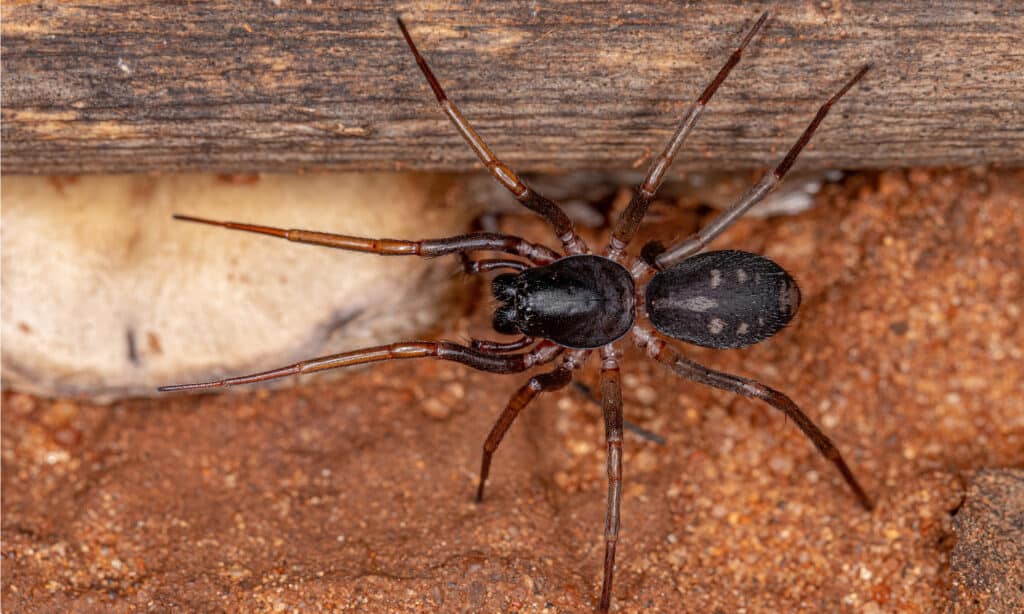
Ant mimic spiders imitate carpenter ants by waving their front legs as if they were antennae.
©Vinicius R. Souza/Shutterstock.com
Summary of 6 Black Spiders in Oregon
| Rank | Spider |
|---|---|
| 1 | Western Black Widow |
| 2 | Mouse Spider |
| 3 | Western Parson Spider |
| 4 | Red-Backed Jumping Spider |
| 5 | Pacific Folding-Door Spider |
| 6 | Long-Palped Ant Mimic Sac Spider |
The photo featured at the top of this post is © Vinicius R. Souza/Shutterstock.com
Thank you for reading! Have some feedback for us? Contact the AZ Animals editorial team.







